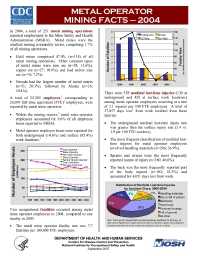Mining Publication: Metal Operator Mining Facts - 2004
Original creation date: September 2007
In 2004, a total of 251 metal mining operations reported employment to the Mine Safety and Health Administration (MSHA). Metal mines were the smallest mining commodity sector, comprising 1.7% of all mining operations. Gold mines comprised 47.0% (n=118) of all metal mining operations. Other common types of metal mines were iron ore (n=29; 11.6%), copper ore (n=27; 10.8%), and lead and/or zinc ore (n=18; 7.2%). Nevada had the largest number of metal mines (n=51; 20.3%), followed by Alaska (n=26; 10.4%). A total of 25,205 employees, corresponding to 26,091 full-time equivalent (FTE) employees, were reported by metal mine operators. Within the mining sectors, metal mine operator employees accounted for 9.6% of all employee hours reported to MSHA. Metal operator employee hours were reported for both underground (14.6%) and surface (85.4%) work locations. Two occupational fatalities occurred among metal mine operator employees in 2004, compared to one fatality in 2003. The metal mine operator fatality rate was 7.7 fatalities per 100,000 FTE employees. There were 558 nonfatal lost-time injuries (130 at underground and 428 at surface work locations) among metal operator employees occurring at a rate of 2.1 injuries per 100 FTE employees. A total of 27,057 days lost from work resulted from these injuries. The underground nonfatal lost-time injury rate was greater than the surface injury rate (3.4 vs. 1.9 per 100 FTE workers). The most frequent classification of nonfatal lost time injuries for metal operator employees involved handling materials (n=206; 36.9%). Sprains and strains were the most frequently reported nature of injury (n=260; 46.6%). The back was the most frequently reported part of the body injured (n=102; 18.3%) and accounted for 4,051 days lost from work. In 2004, 44 cases of occupational illnesses were reported to MSHA by metal operators. This compares to 63 cases reported in 2003. Joint, tendon, or muscle inflammation or irritation accounted for the most frequently reported occupational illnesses (n=29; 65.9%). There were seven cases of hearing loss or impairment reported to MSHA (or 15.9% of all occupational illnesses reported). Metal mining operations reported two cases of heat stroke, sunstroke, heat cramps, etc., accounting for 4.5% of all reported occupational illnesses in 2004.
Authors: National Institute for Occupational Safety and Health
Brochure/flyer - September 2007
NIOSHTIC2 Number: 20032735
Pittsburgh, PA: U.S. Department of Health and Human Services, Public Health Service, Centers for Disease Control and Prevention, National Institute for Occupational Safety and Health, DHHS (NIOSH) Publication No. 2007-168, 2007 Sep; :1-2
See Also
- Coal Operator Mining Facts - 2005
- Metal Operator Mining Facts - 2002
- Metal Operator Mining Facts - 2005
- Noncoal Contractor Mining Facts - 2003
- Nonmetal Operator Mining Facts - 2002
- Nonmetal Operator Mining Facts - 2008
- Sand and Gravel Operator Mining Facts - 2006
- Stone Operator Mining Facts - 2003
- Stone Operator Mining Facts - 2005
- Underground and Surface Mining Facts - 2004
- Page last reviewed: 9/21/2012
- Page last updated: 9/21/2012
- Content source: National Institute for Occupational Safety and Health, Mining Program


 ShareCompartir
ShareCompartir
